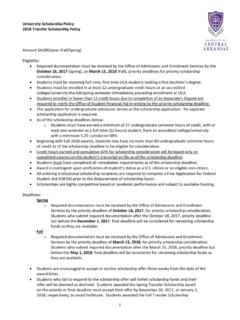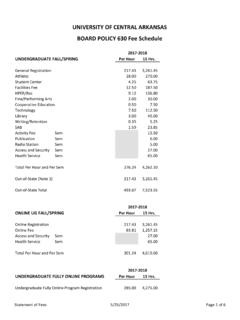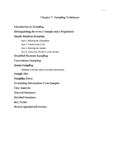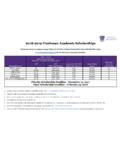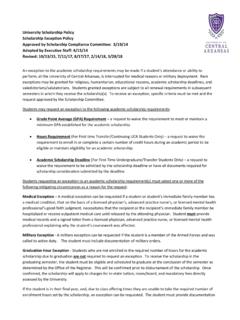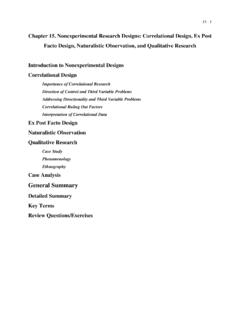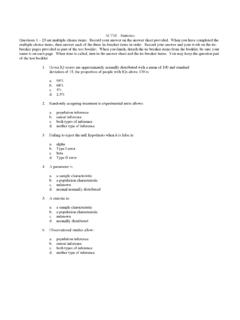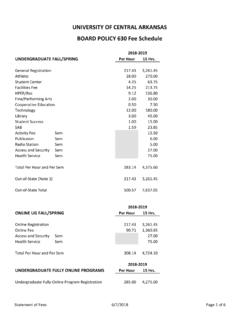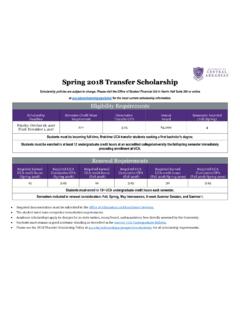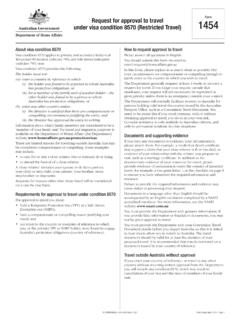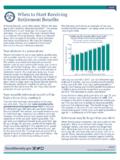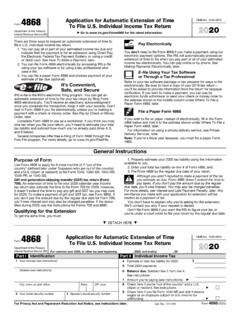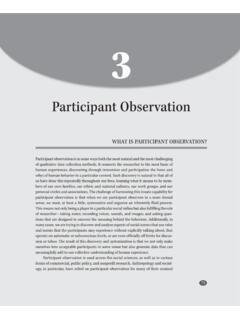Transcription of Chapter 5 Measurement Operational Definitions
1 5-1. Chapter 5. Measurement Operational Definitions Numbers and Precision Scales of Measurement Nominal Scale Ordinal Scale Interval Scale Ratio Scale Validity of Measurement Content Validity Face Validity Concurrent Validity Predictive Validity Construct Validity Thinking Critically About Everyday Information Reliability of Measurement Test Retest Reliability Alternate Form Reliability Split-Half Reliability Factors That Affect Reliability Case Analysis General Summary Detailed Summary Key Terms Review Questions/Exercises 5-2. Operational Definitions An essential component of an Operational definition is Measurement . A simple and accurate definition of Measurement is the assignment of numbers to a variable in which we are interested. These numbers will provide the raw material for our statistical analysis. Measurement is so common and taken for granted that we seldom ask why we measure things or worry about the different forms that Measurement may take.
2 It is often not sufficient to describe a runner as fast, a basketball player as tall, a wrestler as strong, or a baseball hitter as good. If coaches recruited potential team members on the basis of these imprecise words, they would have difficulty holding down a job. Coaches want to know how fast the runner runs the 100-yard dash or the mile. They want to know exactly how tall the basketball player is, the strength of the wrestler, the batting average of the hitter. Measurement is a way of refining our ordinary observations so that we can assign numerical values to our observations. It allows us to go beyond simply describing the presence or absence of an event or thing to specifying how much, how long, or how intense it is. With Measurement , our observations become more accurate and more reliable. Precision is important in all areas of our lives, especially in the sciences and technologies, and we look for ways of increasing it.
3 Here is an interesting classroom demonstration of the precision of numbers versus the precision of words Ask the class members to write down on a piece of paper what number the word several represents to them. Gather the responses and then plot them on the board. You will be surprised at the wide range of numbers represented by the word (it usually ranges from 2 to 7). How often have you been in an argument with a friend, only to find out after much debate that you are using key words in different ways? The argument is one of semantics rather than of issues. You defined the word one way, and your friend defined it a different way. This experience is more common among laypersons than among scientists, but it still occurs. Before the merits of an issue or a position can be discussed, there must be agreement about the meaning of the important terms. The same is true in science. If we are to avoid confusion and misinterpretation, we must be able to communicate unambiguously the meaning of such terms as intelligence, anxiety, altruism, hostility, love, alienation, aggression, guilt, reinforcement, frustration, memory, and information.
4 These terms have all been used scientifically, in very precise ways. Each of these terms could be given a dictionary definition , usually referred to as a literary or conceptual definition . But dictionary Definitions are not sufficiently precise for many scientific terms because they are too general and often too ambiguous. When a word is to be used scientifically or technically, its precise meaning must be conveyed it must be clear and unambiguous. We achieve this clarity of meaning by operationally defining the term. To state the operations for a term means to make the term observable by pointing to how it is measured. An Operational definition , then, makes the concept observable by stating what the scientist does to measure it. 5-3. For example, anxiety could be defined in dictionary terms as a state of being uneasy, apprehensive, or worried. An Operational definition of the term could include observable measures such as sweating palms (observable as sweat gland activity), increased heart rate (observable with heartbeat recording), dilated pupils, and other observable physiological changes.
5 It could also be a self-rating scale or a paper- and-pencil questionnaire. We could in each case specify the precise amounts of each measure necessary for our Operational definition of anxiety. As another example, consider the hypothesis that we proposed in the last Chapter . We hypothesized that the effect of TV violence on older children's aggressive behavior at school will be less if the characters are not human. Although this appears to be a clear statement, more specific Operational Definitions would be necessary before any research could be undertaken to test the hypothesis. The researcher must make several decisions. What is violence on TV? Certainly, one character killing another character would be considered violence. What about a shove or push? What about a verbal assault? What about when Wile E. Coyote falls off the cliff and is hit in the head with a rock? What constitutes a character that is not human? We could probably agree that Wiley Coyote fits this category.
6 What about a computer-animated person? How will aggressive behavior at school be defined? Of course, getting into a fight would be aggressive behavior. What about profanity directed toward another student or teacher? What about little Johnny chasing Mary on the playground? Notice that there are no correct answers to these questions. However, the researcher must decide what is going to be meant by each of the variables in a particular study and be able to communicate those Operational Definitions to those who will be consumers of the research findings. Table contains both dictionary Definitions and Operational Definitions of some common terms. Note that in each case, the Operational definition refers to events that are observable or events that can easily be made observable. Note further that the definition is very specific rather than general. 5-4. The feature that determines whether a particular definition is more useful than another is whether it allows us to discover meaningful laws about behavior.
7 Some will, and some will not. Those Definitions that are helpful to our understanding of behavior will be retained; those that do not will be discarded. The first step in the life of a concept is to define it in clearly unambiguous, observable terms. It then may or may not be useful. If the concept of intelligence were defined as the distance between the ears, or the circumference of the head, its meaning would be clear, but it is very doubtful that it would ever become useful. Let's look at one additional point before leaving the topic of Definitions . An Operational definition , or any other kind of definition , is not an explanation. When Definitions are unintentionally used as explanations, we label them as tautological or circular reasoning. Circular reasoning has little value. A. definition doesn't explain behavior or provide you with information that will, in and of itself, help in understanding behavior. It is a necessary step in discovering lawful relations, but it is only one side of a two-sided law.
8 To explain behavior, two independent (different) types of observation are necessary: one is observations that relate to the independent variable (variable manipulated by the experimenter or cause ), and the second is observations that relate to the dependent variable (behavior of participant or effect ). When the relationship between the independent and dependent variables is predictable, we say 5-5. that we have a lawful relationship. A circular argument uses only one side of the relationship only one of these observations. For example, suppose we observe two children fighting with each other (body contact with intent to harm). We may be tempted to say they are fighting because they are hostile children, because hostility leads to fighting. To this point, we have not explained anything. All we have is an Operational definition of hostility as fighting behavior. Our argument would be a tautology (circular) if we said that the children are fighting because they are hostile and then said that we know that they are hostile because they are fighting.
9 To avoid circularity and to explain the behavior, we would have to define hostility and fighting independently and show that the operations for defining hostility do in fact give rise to fighting. Tautological reasoning occurs with a higher frequency than it should. For example, it is not uncommon to hear the statement Individuals who commit suicide are mentally ill. To the question How do you know they are mentally ill? the response is often Because they committed suicide.. Another common tautology refers to musical ability. For example, it is said Individuals who play the piano well do so because they have musical ability. To the question How do you know they have musical ability? the response is Because they play the piano well. Another example is Individuals drink excessively because they are alcoholics. We know that they are alcoholics because they drink excessively. We repeat, tautological arguments do not advance our knowledge.
10 To avoid circularity in our last example, we would have to define what we mean by drinks excessively and then identify the factors that give rise to drinking excessively for example, genetics, specific early experiences, or stressful events. We then would have an explanation for the drinking. Numbers and Precision As noted earlier, Measurement scales are important because they allow us to transform or substitute precise numbers for imprecise words. We are restricted in what we can do with words but less so with numbers. Numbers permit us to perform certain activities and operations that words do not. In many instances, numbers permit us to add, multiply, divide, or subtract. They also permit the use of various statistical procedures. These statistics, in turn, result in greater precision and objectivity in describing behavior or other phenomena. At a minimum, we know that the numbers 1, 2, 3, 4, and so on, when applied to the frequency of occurrence of any event, mean that 4 instances are more than 3, which in turn are more than 2, and so on.
